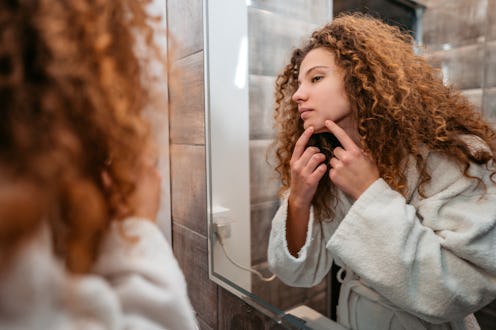(Skin)
Why Fungal Acne Tends To Pop Up In The Summer
Hint: Your usual pimple cream might not cut it.

It’s a skin care query so common yet confounding, it has yielded an entire 25,000-member subreddit all dedicated to helping answer the question: Do I have fungal acne? It’s something you might be familiar with if you have sensitive skin, as an estimated half of all people do. Often caused by pore-clogging occlusives that lead to buildup and subsequent infection, those with a fungal acne flare-up will notice a rash-like pattern of small white bumps, not dissimilar to whiteheads. Before learning how to get rid of fungal acne, it’s helpful to understand what it is exactly.
Unlike whiteheads, fungal acne technically isn’t even acne at all — it’s a yeast infection of hair follicles. As such, while it might be tempting to try to flatten every bump with some slash-and-burn chemical exfoliants and spot treatments, fungal acne won’t react the same way that a classic zit might. To help you make sense of this common issue (and shed some light on how to fight, heal, and prevent fungal breakouts), TZR turned to a suite of skin care experts. Scroll on for your complete guide to dealing with — and treating — fungal acne.
Fungal Acne Vs. Regular Acne
To defeat fungal acne once and for all, it’s important to understand the ways in which it’s similar to and different from what’s considered “regular” acne. According to Dr. Paul Jarrod Frank, M.D., cosmetic dermatologist and founder of PFRANKMD, the chief difference between the two is what actually causes each type of acne and the ways it presents itself. “They can appear very similar,” he says, “but fungal acne is more itchy or irritating in sensation.” Though the idea of yeast growing on your face seems both foreign and terrifying, it’s actually native to the skin’s biome, along with bacteria and even fungus — but when any of them grow disproportionately, that’s when trouble kicks off.
Rachel Roff, skin care expert and founder of Urban Skin RX, explains that fungal acne is specifically caused by unchecked yeast growth. By comparison, she says, “traditional acne is caused more by oil production, bacteria, and hormones and tends to be on the sorer side,” rather than itchiness and rash-like irritation.
Fungal Acne Signs & Symptoms
“Fungal acne can look like regular acne, but there are key differences,” Sue Y. Nabi, founder of vegan skin care line Orveda, tells TZR. While regular acne breakouts vary in size, type, and location (think nose blackheads versus a back cyst), “fungal acne will usually appear as red bumps or pustules of the same size, but they will be visible mainly on the chest, upper arms, and back,” Nabi says.
If your regular acne treatments aren't working, that may be a sign that it's more than just the traditionally topical sort. “Be suspicious if acne doesn't respond to traditional therapies that focus on bacteria and hormone imbalances,” Dr. Frank says. Another key factor to consider is the placement of the acne. According to Roff, rarely will fungal acne present as one-off bumps. “It appears more in clusters,” she confirms.
What Causes Fungal Acne?
In short, fungal acne is caused by an imbalance in your body’s natural yeast and bacteria (the good kind, that is). “If you do something that wipes out the healthy bacteria — like using harsh anti-bacterial washes, occlusive oily skin care, or just taking antibiotics — there won’t be anything to keep the fungus in check,” Nabi explains. She says that as a result, that fungus can overdevelop, which opens the door to irritation, inflammation, and fungal acne.
“On top of antibiotics, anything that will create an occlusive, moist zone — think tight, non-breathable clothes like workout clothes or tight clothes that are not washed regularly — will help fungal acne to appear,” Nabi says. It’s not just surface-level either. Nabi explains that genetics can play a role in who’s predisposed to fungal acne. “A weak immune system is also usually associated with fungal acne,” she adds.
How To Treat Fungal Acne On Your Face
While shampoo isn't usually suggested for the body and face, it has proven one of the most effective treatments for fungal acne. “It's been noted that dandruff shampoo actually helps because it kills the pityrosporum fungal type,” Frank says.
Roff agrees, vouching for the method as well. “It is recommended to wash the area and leave the shampoo on the skin for two to three minutes and then rinse. This is especially great to do after a workout.” But shampoo isn't the only successful remedy. “It's best to use products with sulfur since this ingredient is antibacterial,” Roff explains. “Salicylic acid is another good option for acne. If a body wash or any other products with these ingredients don’t work after a few weeks, then it might be time to see a dermatologist so they can prescribe an oral medication.”
Trying to treat fungal acne with traditional treatments may actually make it worse. “Common acne treatments, especially antibiotics, won’t help at all and might even make your fungal acne worse because they will kill the protective healthy microbiome," Nabi says. “To keep the results and the skin in optimal condition, it is also recommended to use gentle and microbiome balancing skin care that has the power to boost beneficial bacteria and that does not create an unbalance in [the] skin microbiome.”
In the hotter months, it's important to consider your clothing, too. “Try not to wear restrictive clothing, and keep your skin dry after working out and throughout the day,” Roff advises.
Shop Fungal Acne Treatment Products
We only include products that have been independently selected by TZR's editorial team. However, we may receive a portion of sales if you purchase a product through a link in this article.
This article was originally published on